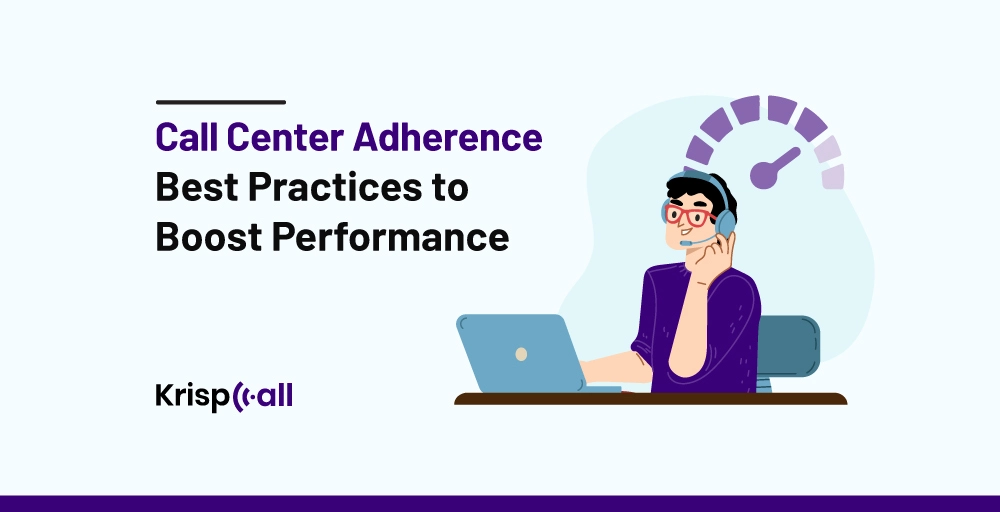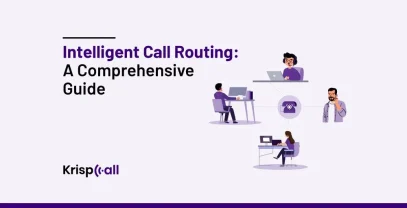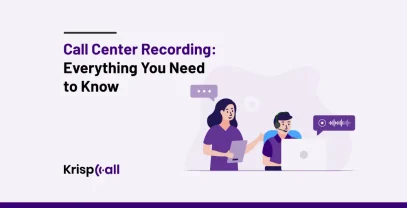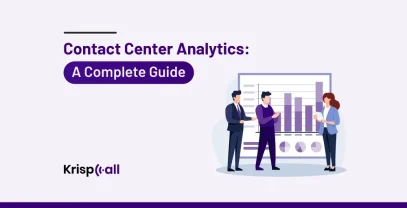Most Call Centers aim to achieve an 80% schedule adherence rate mainly because the target of 100% is unrealistic and almost impossible to achieve.
The majority of customers still rely on call centers to hear their concerns and resolve them. Approximately 71% of consumers expect call centers to deliver interactions and resolutions. The ultimate goal of any call center is to provide excellent customer service and efficiency.
Call centers and the management always aim to improve efficiency and customer service through innovative measures. One of the best ways to achieve this is by implementing call center adherence to boost the agent’s performance.
So, in this blog, we will discuss the 10 call center adherence best practices to boost performance.
The Definition: Call Center Adherence
Schedule adherence is a call center metric used to determine whether agents complete their daily activities at the appointed times. In other words, it compares a call center agent’s active work during working hours and the tasks they are given to complete.

A high adherence percentage or rate indicates that the agents are making good use of their time and providing the clients with high-quality service. At the same time, a lower adherence percentage will suggest that the call center representatives aren’t following their allotted timetables or completing their assigned tasks.
💡 Also Read: Best Ways To Improve Call Center Productivity in 2024
Importance of Call Center Adherence
- Decreased customer wait times due to timely agent availability, which increases customer satisfaction and loyalty.
- Effective staffing that is based on adherence reduces expenses and increases productivity within the call center.
- Adherence helps to keep operations running smoothly even at busy times by reducing interruptions.
- Adherence fosters a disciplined and accountable work environment, which also improves team performance by delegating responsibility.
- Adherence offers useful information for well-informed decision-making, enabling predictive changes and adjusting schedule plans for continuous operational improvement.
What are Call Center Adherence Standards?
Call center adherence standards are objective metrics that are used to quantify and define what constitutes good use of time. Your call center adherence standards determine how well your customer relationship team serves your customers. This process ensures all inquiries are answered satisfactorily and that no questions are unanswered.
👉 You might also be interested in After Call Work (ACW): What Is It and How Can It Be Improved?
How to Calculate Schedule Adherence in a Call Center?
Calculating schedule adherence in a call center is a very simple and straightforward process. You can just follow the simple formula as presented below.
AdherencePercentage = (Scheduled Time/ Actual worked Time )×100
Here is a step-by-step process of calculating schedule adherence in a call center.
- Step 1: Record the actual work time, including the time spent on calls, breaks, and other work-related activities.
- Step 2: Identify and determine the scheduled time for each call center agent.
- Step 3: Apply the formula mentioned above.
For example, Let’s consider an agent, Mr. A, who is scheduled to work 8 hours. However, when his actual work time was calculated, it was found he only worked 7.5 hours.
So, AdherencePercentage = (8/ 7.5)×100 = 93.75%
This indicates that Mr. A adhered to his schedule 93.75% of the time, which is a good degree of compliance with his work hours.
10 Best Practices for Call Center Schedule Adherence and Ways to Improve It
Our experts have conducted various studies and found some of the most effective ways to improve call center schedule adherence. So, let’s examine these best practices for call center schedule adherence.
1. Set a Realistic Schedule and Schedule Adherence
First and foremost, management and supervisors must set realistic schedules for all the agents. If the schedule is unrealistic, agents will not be able to follow through and will lose motivation. An ideal schedule must include enough breaks and the right amount of work time.

Likewise, supervisors should also be careful while setting the schedule adherence. For instance, the call adherence of 100% might seem appealing to everyone, but it cannot be achievable. So, supervisors can calculate the current adherence and make sensible targets.
2. Communicate the Importance of Schedule Adherence
Supervisors and managers should communicate and discuss the importance of schedule adherence from day one. This can be done during recruiting and onboarding, which significantly reduces the chances of employees developing bad habits.
Moreover, the managers should practice a sense of accountability among the agents to ensure they give their best during working hours. This method has been proven to be effective and sustainable for a long time.
3. Offer Some Flexibility in the Schedule
Agents with rigorous and rigid schedules will likely not follow it. So, there should be some flexibility in short breaks and time off that does not impact individual or group work.
Furthermore, managers can use workforce management tools to allow agents to adjust their shifts as needed, which might result in improved adherence. In the best case, agents may even be able to swap shifts without a long process. This creates a positive work environment, which helps improve schedule adherence.
4. Provide Supplemental Training
If an agent needs more assistance staying on track and completing their work on time, you can provide them with extra coaching or training. Consider alternatives like workshops, conferences, and seminars instructing employees on maintaining concentration during their shifts.

Additionally, you should provide one-on-one progress updates or counseling services if employees cannot stick to their schedules outside of work.
5. Create a Reward System
Agents may be able to achieve their objectives with the use of incentives. Team members can be motivated to stick to their schedules, arrive on time, and avoid distractions if they are given some monetary bonuses, awards, and other similar rewards. Those who already adhere to their schedules can also be rewarded with incentives that motivate them to do even better.
A study on the impact of reward systems on worker productivity found that bonus plans and employee performance are positively correlated. Therefore, call centers should implement a rewards program to incentivize agents to stick to their schedules.
6. Establish the Schedule Adherence as a Company Culture
Managers should be aware that it is possible to motivate team members to be more productive and efficient by highlighting the significance of adhering to the scheduling standards. Enhancing adherence and participation can be achieved by establishing a culture of fairness and clarity regarding expectations.
Moreover, managers must remember that employees should be rewarded for their efforts. Penalizing delay should be avoided, as it might discourage them in the coming days.
7. Monitor Agents
The best method to make sure that the scheduling efforts are successful is to keep track of everything and observe the performance of the agents. You can track an agent’s progress and determine how they’re actually spending their time by employing call center technology.
If you see that some agents aren’t keeping to their schedules, provide them with constructive criticism. This can help a lot in aligning schedule adherence with employee performance.
8. Identify the Reasons for Agents to go Out-of-adherence
If many agents are out of adherence, consider identifying the common reasons before making any decisions. So, call centers should first look for the causes of the need for change before attempting to increase adherence.
It’s critical to identify the factors or circumstances that include the reasons, such as agents arriving late, taking longer lunch breaks, engaging in excessive chatter while at work, etc. Find out the specific reasons that are driving your agents away from adherence. In addition, it is crucial to identify any specific time or days on which adherence is normally low.
9. Use Employment and WorkForce Management Tools
If you don’t get results even after trying everything, consider using an employee and workforce management tool. A workforce management (WFM) tool is a software program that companies use to automate and streamline the procedures involved in effectively allocating their labor force and managing agents’ time.

These technologies can be used in call centers to create effective and reasonable timetables that agents can adhere to. Moreover, this tool offers a one-stop solution for monitoring all the agents’ performance and making decisions.
10. Reconsider the Schedule
Last but not least, reconsidering the schedule might be one way to improve schedule adherence in the call center. If a large number of call agents need help meeting the schedule adherence threshold, it might mean that the schedule has some issues.
So, assess the schedule and the other requirements, ensure it is attainable, and communicate the updated schedule to every agent.
You can use these practices to implement and improve schedule adherence in your call center.
👉 You might also be interested in How to Handle Angry Customer Calls in a Call Center.
What are the Benefits of Tracking the Call Center Adherence in a Call Center?
Call Center Adherence in a call center primarily focuses on ensuring whether call center agents are sticking to their assigned tasks and working the designated hours or not.
However, call center adherence is much more than checking when the agents clocked in and out. It is a method of providing outstanding customer service by aligning resources to demand and encouraging an accountable culture.
So, let’s cover some of the benefits of tracking call center adherence.
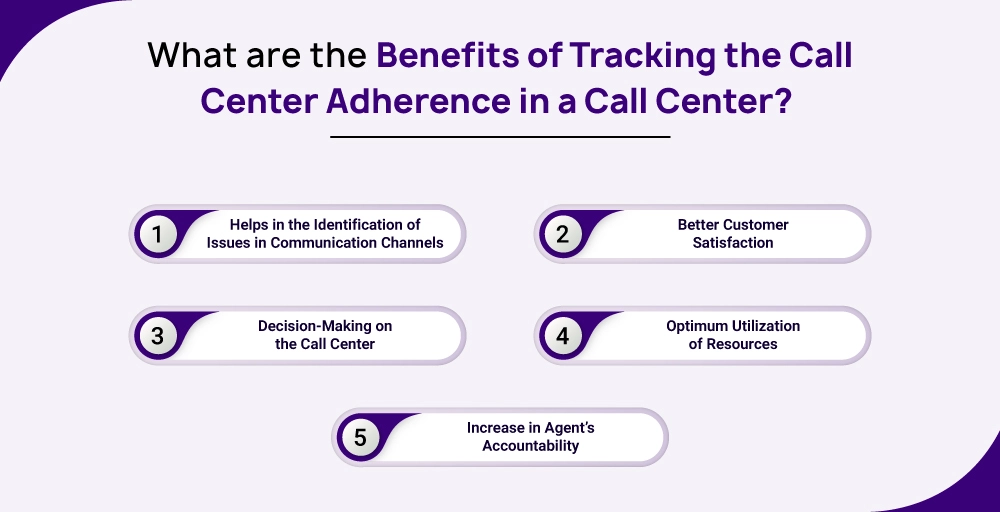
1. Helps in the Identification of Issues in Communication Channels
Adherence reporting is beneficial when channels like email or phone start experiencing problems. For instance, a number of factors could be at play if phone call handle times suddenly increased. While adherence reporting is limited in its ability to address every aspect of a problem, it can offer important insights regarding agent trends.
It’s possible that phone problems are getting more time-consuming and challenging to resolve if some agents are taking longer breaks and are not adhering to adherence to standards. As a result, call centers can take the necessary steps to identify and solve such issues.
2. Better Customer Satisfaction
Tracking the call center adherence in a call center ensures agents are following their schedule strictly. When all call center agents adhere to their assigned schedule, there is a good chance that agents are available when customers need assistance. As a result, there are timely responses and reduced wait times for all the customers. This ultimately leads to better customer satisfaction.
3. Decision-Making on the Call Center
The tracking of call centers can significantly help in the decision-making process. First, data on adherence can provide insight into workforce efficiency and potential areas for improvement.
A WFM analyst might find some agents consistently miss their adherence targets by a significant margin. To be notified when one of these agents unexpectedly falls out of compliance, the analyst can schedule adherence alert reports at predetermined intervals. This saves the agents the trouble of manually monitoring their adherence status every day.
Based on this information, the WFM analyst can make or suggest decisions for these agents
4. Optimum Utilization of Resources
When the call center tracks the call agents’ adherence, they can estimate and determine the ideal number of staff for their call center. This, in turn, can help optimize staff levels to perfectly match demand. Efficient resource allocation prevents overstaffing or understaffing, maximizing productivity.
🥳What’s better than the ideal number of staff in a business? Neither are there more staff than required, saving resources for business nor are there less staff than required, which prevents pressurizing the existing staff.
5. Increase in Agent’s Accountability
The tracking of call centers might alert the agents that their performance is being monitored. This can motivate them to perform better. As a result, adherence tracking establishes accountability among agents to adhere to their schedules. In addition, this encourages a sense of responsibility, improving overall team performance.
What Factors Impact Call Center Schedule Adherence?
The factors and reasons for call center schedule adherence issues can differ for every call center business. So, we have researched and collected a number of reasons and factors companies have reported for issues related to schedule adherence.
- Call center agents spend too much time on things unrelated to their work, like surfing through social media, checking emails, and engaging in personal calls.
- Punctuality issues where call center agents come to work late or leave early frequently.
- Agents’ absenteeism without any prior notice.
- Inefficient scheduling leads to overstaffing or understaffing during different call volume patterns.
- Inadequate training to the agents which makes it difficult for call agents to manage their time.
- Agents take unscheduled or longer breaks or spend a long time with co-workers.
- Disruption in communication channels. For example, damaged telephone lines, Software glitches, and dropped calls.
- Weather-related or power outage-related loss of internet or system connectivity.
- Assigning a busy or away status to your account when you are available to take calls.
What are the Ways of Enhancing Call Center Adherence Through Technology?
There are many traditional ways of enhancing call center adherence. However, it has been proven that the ways of enhancing call center adherence through technology are much more effective and efficient in producing results. So, let’s have a look at a few of them.

1. Artificial Intelligence (AI)
First and foremost, Artificial Intelligence (AI) can be a great tool for enhancing call center adherence. Every business and sector is implementing AI in their operation, so why not integrate it into call center business?
AI can help use and understand the previous data and predict the trends for call volumes. This estimation can help a business prepare a proper plan on how to optimize the resources and agents for maximum benefits. In this way, proactive scheduling adjustments can be made to align with expected demand.
It only gets better as AI can additionally be used to adjust agent schedules instantly in response to fluctuations in call volume or unexpected events. Additionally, AI can be used to adjust agent schedules instantly in response to fluctuations in call volume or unexpected events. All this helps in enhancing call center adherence.
2. WorkForce Management (WFM) Software
Next, we have WorkForce Management software or simple WFM software. A workforce management (WFM) tool is a software solution that is used by businesses for streamlining and automating the processes that manage employees’ time and deploy their labor force efficiently.
In the case of call centers, these tools can be used for preparing efficient and realistic schedules for agents to follow. Efficient scheduling can be very helpful to allocate and optimize all the agents to an optimum level. There are some great WFM tools available in the market. For instance, you can choose one among the following:
- Connecteam
- Deel
- Arcoro
- Paycor
- Justworks
What’s better is that WFM software can also be used as a central monitoring tool to compare the adherence of each agent and make decisions to improve them.
3. Performance Tracking Software
Like WFM tools, call center businesses can also use performance tracing software in their operation. For this, the management can choose either an individual performance tracking system or a team performance tracking system.
This can be used to assess the performance of each agent, find their strengths, and identify room for improvement. Moreover, this software can be very beneficial for decision-making and implementing various strategies. Moreover, if there are issues in the performance of many agents, there might be problems in the schedule or the infrastructure, which can be revised.
There are many performance tracking software available in the market; you can go with any of the following:
- Workday
- PerformYard
- BambooHr
- Betterworks
4. Automated Communication Channels
Next, we have automated communication channels, which are one of the best technological ways of enhancing call center adherence. Automated communication channels help reduce disruption and distribution, which are common in manual communication channels. This channel helps streamline the communication process.
But wait! There is more. Using automated communication channels, agents can get timely notifications about shifts, breaks, and alterations, ensuring seamless workflow continuity. This process can also significantly improve the overall call center adherence.
5. Speech Analytics
Lastly, we have speech analytics. It is a new concept in the call center business; however, it has the potential to be one of the most effective ways to improve call center adherence. Customer interactions can be analyzed through speech analytics to uncover patterns and trends that impact customer adherence.
Conclusion
To sum up, excellent call center adherence is necessary for peak performance and customer satisfaction. You can review the ten best practices for improving call center adherence in your business, as mentioned above.
In addition, Call center schedule adherence is crucial for creating a culture of accountability, and leveraging rewards contributes to a disciplined and motivated workforce. Furthermore, there are both traditional and technological methods of attaining better adherence in your call center. You can apply any one of them as per your need.
Finally, you can use a virtual phone number from some of the best providers, like KrispCall, which offers a number of call center features, like call monitoring, call whispering, and call listening. In addition, it also offers a number of call center integrations for the best call center operation.

